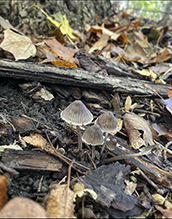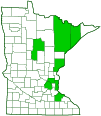Nitrous Bonnet
(Mycena leptocephala)
Conservation • Description • Habitat • Ecology • Distribution • Taxonomy
Conservation Status |
|
|||||||
| IUCN Red List | not listed |
|||||||
| NatureServe | NNR - Unranked |
|||||||
| Minnesota | not listed |
|||||||
Description |
||
Nitrous Bonnet is a small, fragile, gray, gilled mushroom. It occurs in Europe, Asia, New Zealand, Chile, and North America. In the United States it occurs in the east from Maine to North Carolina, west to Minnesota and eastern Texas. In the west it occurs west of the Rocky Mountains from northern Washington to southern California. It also occurs in Alaska, and there are scattered populations from Idaho south to Arizona and New Mexico. It is found alone, scattered, or in groups but not clustered (gregarious), in coniferous and mixed woodlands. It fruits from spring through fall but especially in spring to early summer and in late fall. It grows on the ground on coniferous debris, including sticks, needle carpets, and cones. It obtains its nutrients from decaying wood (saprobic). When it first appears, the cap is broad but cone-shaped, and black to dark grayish-brown. The upper surface is densely covered with fine white powder, and the margins are pressed closely to the stalk. As it ages the cap flattens out, the powder wears off completely, and the color fades. The mature cap is broadly cone-shaped, convex, or broadly bell-shaped. It is usually ⅜″ to 1¼″ (1 to 3 cm) in diameter, sometimes up to 1½″ (4 cm) in diameter. The upper surface is grayish-brown or gray, free of powder, moist, and strongly lined. The margins are whitish. The gills are narrow and moderately well spaced. There are 18 to 27 main gills, and between the main gills there are one or two series of short gills that do not extend to the stalk. The main gills curve upward approaching the stalk and are either narrowly attached to the stalk or are attached with a tooth that extends slightly down the stalk. The gills are whitish or pale gray with whitish edges. The stalk is fragile, hollow, 1¼″ to 2¾″ (3 to 7 cm) long, and 1⁄32″ to ⅛″ (1 to 3 mm) thick, equal in size from top to bottom. It is black to dark brown and covered with whitish powder at first. As it ages it fades to grayish or brownish and becomes free of powder. The flesh is thin, fragile, and grayish. It has a mild odor of bleach that becomes strong when the flesh is crushed. It is not known if it is edible, but the taste is acidic and unpleasant. The spore print is white. |
||
Similar Species |
||
Habitat and Hosts |
||
Coniferous and mixed woodlands. Debris of conifers. |
||
Ecology |
||
Season |
||
Spring through fall |
||
Distribution |
||||
|
Sources |
|||
| 12/10/2022 | ||||
Occurrence |
||||
Not common in Minnesota |
||||
Taxonomy |
|||
| Kingdom | Fungi (Fungi) | ||
| Subkingdom | Dikarya | ||
| Phylum | Basidiomycota (Basidiomycete Fungi) | ||
| Subphylum | Agaricomycotina (Higher Basidiomycetes) | ||
| Class | Agaricomycetes (Mushrooms, Bracket Fungi, Puffballs, and Allies) | ||
| Subclass | Agaricomycetidae | ||
| Order | Agaricales (Common Gilled Mushrooms and Allies) | ||
| Suborder | Marasmiineae | ||
Family |
Mycenaceae | ||
Genus |
Mycena (bonnets) | ||
Synonyms |
|||
Agaricus alcalinus ssp. leptocephalus Agaricus leptocephalus Mycena alcalina var. chlorinella Mycena chlorinella |
|||
Common Names |
|||
Nitrous Bonnet |
|||
Glossary
Saprobic
A term often used for saprotrophic fungi. Referring to fungi that obtain their nutrients from decayed organic matter.
Visitor Photos |
|||||
Share your photo of this fungus. |
|||||
| This button not working for you? Simply email us at info@MinnesotaSeasons.com. Attach one or more photos and, if you like, a caption. |
|||||
Honey Fae (Farah) |
|||||
 |
|||||
MinnesotaSeasons.com Photos |
|||||
|
|||||

Slideshows |
||

Visitor Videos |
|||
Share your video of this fungus. |
|||
| This button not working for you? Simply email us at info@MinnesotaSeasons.com. Attach a video, a YouTube link, or a cloud storage link. |
|||
Other Videos |
|||
| Mycena alcalina and Mycena leptocephala are very similar Paul Stamets |
|||
About
Nov 10, 2019 Mycena alcalina and Mycena leptocephala are very similar, sharing the strong smell of chlorine (bleach) when crushed. When we tested specimens for chlorine, none was found. Many questions naturally come to mind. Is this chlorine-mimicking smell attractive to certain insects that help it spread spores? Or conversely, to repel insects from predating upon them? Why would a mushroom out-gas such a distinctive odor? Is it non-consequential? Humans have a tendency to find meaning in nature when there may be none. In my mind, at this stage in evolution, the presence of such strong chlorine-mimicking molecules is likely related to relationships these species have that are beyond our present knowledge. . I initially thought that this species might be a good candidate for breaking down chlorine-bound toxins, like PCB’s (polychlorinated biphenyls). The work we did with Battelle Laboratories and New Fields (with Dr. Jack Word), revealed that many white rot fungi could decompose’ PCB’s if the PCB’s were the predominant “nutrient” in the media. However, when we inoculated PCB contaminated soil, the mycelium prefers other easy-to-digest foods. Nevertheless, a good example of epigenesis - that we could train a fungal strain to up-regulate genes to code for enzymes that have a talent for detoxifying these carcinogens. |
|||

Created: 12/10/2022
Last Updated:


